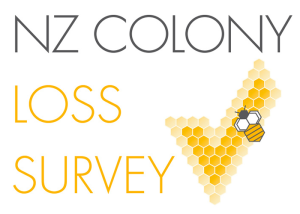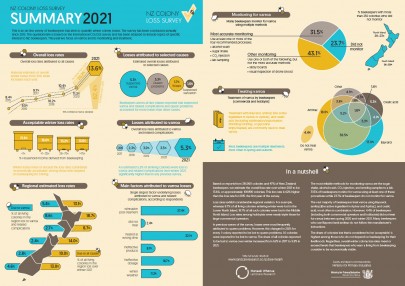2021 Colony Loss Survey
In this section
 Survey topics include the number and nature of over-winter colony losses, queen health and performance, indicators of diseases and parasites, treatment of Varroa, supplemental feeding, and colony management. Because the challenges facing New Zealand beekeepers differ from those facing beekeepers in the northern hemisphere, the survey also includes questions that are specific to to the New Zealand context, e.g. apiary crowding, predation by wasps, and nectar flow from native trees.
Survey topics include the number and nature of over-winter colony losses, queen health and performance, indicators of diseases and parasites, treatment of Varroa, supplemental feeding, and colony management. Because the challenges facing New Zealand beekeepers differ from those facing beekeepers in the northern hemisphere, the survey also includes questions that are specific to to the New Zealand context, e.g. apiary crowding, predation by wasps, and nectar flow from native trees.
In a nutshell
Based on reports from 381,000 colonies and 47% of New Zealand beekeepers, we estimate the overall loss rate over winter 2021 to be 13.6%, or approximately 109,800 colonies. This loss rate is 62% higher than the loss rate for 2015, the first year of the survey.
Loss rates exhibit considerable regional variation. For example, whereas 8.7% of all living colonies entering winter were lost in the Lower North Island, 18.7% of all such colonies were lost in the Middle North Island. Loss rates among hobbyists were nearly triple those for large commercial operators.
In previous waves of the survey, losses were most frequently attributed to queen problems. However, this changed in 2021: for every 1 colony reported to be lost to queen problems, 1.6 colonies were reported to be lost to varroa. The share of all colonies reported to be lost to varroa over winter increased from 1.6% in 2017 to 5.3% in 2021.
The most reliable methods for monitoring varroa are the sugar shake, alcohol wash, CO2 injection, and sending samples to a lab. 31.5% of beekeepers monitor for varroa using at least one of these procedures while 23.7% of beekeepers do not monitor for varroa.
The vast majority of beekeepers treat varroa using Bayvarol, amitraz (the active ingredient in Apivar and Apitraz), and oxalic acid, most often in combination. However, 4.4% of beekeepers (including both commercial operators and hobbyists) did not treat for varroa between spring 2020 and winter 2021. Many beekeepers who use Bayvarol and amitraz do not follow the manufacturer’s instructions.
The share of colonies lost that is considered to be ‘acceptable’ is highest among those who do not depend on beekeeping for their livelihoods. Regardless, overall winter colony loss rates meet or exceed levels that beekeepers who earn a living from beekeeping consider to be economically viable.
2021 overwinter losses













Varroa






















2020/21 Season




























